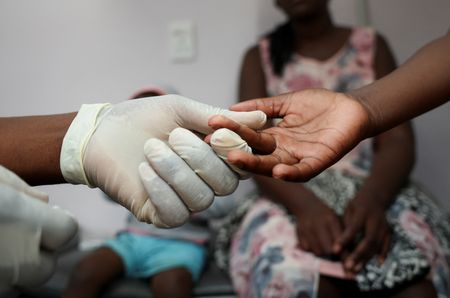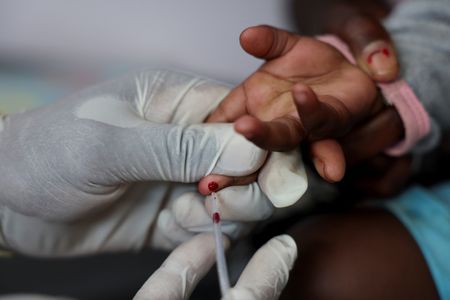By Nellie Peyton
JOHANNESBURG (Reuters) -Testing and monitoring of HIV patients across South Africa have fallen since the United States cut aid that funded health workers and clinics, with pregnant women, infants and youth the most affected, previously unpublished government data shows.
South Africa has the world’s highest burden of HIV, with about 8 million people – one in five adults – living with the virus. The United States was funding 17% of the country’s HIV budget until President Donald Trump slashed aid early this year.
Data from the National Health Laboratory Service, a government entity, showed that viral load testing fell by up to 21% among key groups in the last two months, which four HIV experts said appeared to be due to the loss of U.S. funding.
Viral load testing measures how much virus is in the blood of people living with HIV who are on anti-retroviral treatment. It is normally done at least once a year.
It checks whether the treatment is working and whether the virus is sufficiently suppressed to prevent it spreading to others.
With less testing, fewer people who may transmit the virus will be identified. Missing a test can also indicate that a patient has dropped out of the system and may be missing treatment.
It is especially important for pregnant women who may be at risk of transmitting HIV through childbirth, and for infants who need to be diagnosed and treated early to survive.
Trump froze many foreign aid programmes early in his presidency, before reinstating some lifesaving assistance, including parts of the United States President’s Emergency Plan for AIDS Relief (PEPFAR), its global HIV initiative. But South Africa was also specifically targeted, with an executive order cutting all funding to the country in February.
South Africa did not rely on U.S. funding for its HIV drugs, but about 15,000 health workers’ salaries were paid by PEPFAR, which previously gave South Africa over $400 million a year. Most of that funding has been withdrawn, though it is unclear exactly how much.
The health workers did HIV testing and counselling in districts with a high prevalence of HIV, and followed up when patients missed a check-up or dropped off treatment, which is common.
The PEPFAR funding also supported NGO-run clinics which have now closed. The government has urged HIV patients who did check-ups at those clinics to go to public health centres instead, but public health centres often have long lines and staff can be unwelcoming to certain groups like sex workers or gay men.
‘SHOCKING FIGURES’
According to the data seen by Reuters, the number of viral load tests conducted for people aged 15-24 fell by 17.2% in April compared to April last year, after dropping 7.8% year-on-year in March. Total population testing was down 11.4% in April.
Maternal viral load testing was down 21.3% in April after falling by 9.1% in March, and early infant diagnostic testing was down 19.9% in April after falling by 12.4% in March, the same data showed.
The percentage of people who were virally suppressed among those tested also fell nationwide by 3.4% in March and 0.2% in April, with steeper declines for young adults, a further sign that patients may have had their treatment interrupted, the data showed.
The data has not been made public.
“These are shocking figures, with profound implications for maternal and child health across the country,” said Francois Venter, executive director of the Ezintsha Research Centre in Johannesburg.
Given a summary of the data, Foster Mohale, a spokesperson for South Africa’s Department of Health, said more analysis was needed and that South Africa already had challenges with patient retention and viral load testing before the aid cuts.
But HIV experts have said for months that the health ministry was downplaying the impact of the funding loss in South Africa, and that a drop in testing figures might be an early warning sign – followed by a rise in new cases and deaths.
The U.S. State Department did not immediately respond to a request for comment.
“This data demonstrates what previous models have shown regarding the impact of PEPFAR/USAID cuts on pregnant women and their infants,” said Dvora Joseph Davey, an epidemiologist working on maternal and infant HIV at the University of Cape Town.
She said the impact was clear at five public health clinics where she works in Cape Town, which since the U.S. aid cuts have been under-staffed, with fewer nurses to draw blood which is needed for viral load tests.
‘GOING TO DIE’
HIV experts said that diagnostic testing was likely impacted by the funding cuts too, though that data was not available.
The counsellors who used to do rapid diagnostic HIV tests are also gone, and pregnant women are no longer being put on preventative HIV drugs (PrEP) because the counsellors are the ones who used to offer that, Davey said.
In the Johannesburg township of Diepsloot, HIV activist and community leader Sophy Moatshe said it was hard to get HIV patients to seek care because of the stigma, and that without health workers reaching out when they miss an appointment, many fall through the cracks.
“These people, they don’t want to go to the clinic,” she said outside a community centre in the crowded informal settlement. “If there is nobody to check them, they’re going to die.”
The long-term future of HIV-related U.S. assistance remains uncertain in South Africa and globally, as Trump pursues significant cuts to the international aid budget in line with his “America First” agenda.
The cuts have also hit research, including HIV vaccine trials.
Department of Health spokesperson Mohale said the government was speaking to prospective local and international donors about covering funding gaps, but declined to give details.
The data on testing in April, however, was “a good indication of what’s going to happen in the future,” said Davey.
(Reporting by Nellie Peyton; Editing by Tim Cocks and Aidan Lewis)









